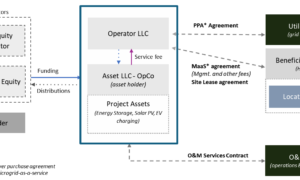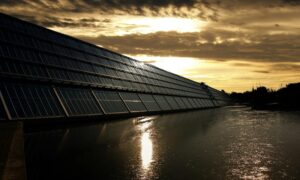In the dynamic intersection of renewable energy and technology, a formidable partnership is shaping the future of sustainable practices. This collaboration not only addresses pressing environmental concerns but also propels us towards a cleaner and more efficient energy landscape.
Introduction
The Rise of Renewable Energy
Solar Power’s Evolution
The journey from basic photovoltaic cells to smart solar panels has transformed solar energy into a reliable and efficient source. Advanced tracking systems optimize energy absorption, making solar power a viable option even in regions with varying sunlight intensities.
The Rise of Renewable Energy
Solar Power’s Evolution
Renewable energy has experienced a remarkable surge in adoption, driven by a global shift towards sustainable practices. Among the various sources, solar power has undergone a notable evolution.
From Basic Photovoltaic Cells to Smart Solar Panels
From the early days of basic photovoltaic cells, solar technology has advanced to incorporate smart features in today’s solar panels. These panels go beyond mere energy conversion; equipped with sophisticated tracking systems, they can dynamically follow the sun’s movement.
Optimizing Energy Absorption
This technological leap optimizes energy absorption throughout the day, making solar power not only more efficient but also a practical solution for regions with fluctuating sunlight intensities.
Innovations in Wind Energy
In tandem with solar advancements, wind energy has undergone a transformative journey.
Turbine Design Revolution
Innovations in turbine design and the integration of predictive analytics have propelled the efficiency of wind turbines to new heights. Modern turbines, equipped with sensors and AI algorithms, are capable of predicting wind patterns.
Maximizing Energy Production
This predictive capability ensures optimal positioning of the turbine blades, maximizing energy production and reliability from wind farms. The result is a more consistent and dependable source of clean energy.
Hydropower’s Technological Leap
Hydropower, a well-established player in the renewable energy landscape, has not been left behind in the march of technological progress.
Smart Dam Systems
The implementation of smart dam systems showcases the commitment to minimizing the environmental impact of hydropower.
Fish-Friendly Turbine Designs
The development of fish-friendly turbine designs enhances the efficiency of hydropower while simultaneously minimizing its environmental impact.
Geothermal Energy’s Resurgence
Geothermal energy, often overshadowed by more mainstream sources, is experiencing a resurgence.
Enhanced Geothermal Systems
Technological innovations, including enhanced geothermal systems, have expanded the accessibility of geothermal energy.
Advanced Drilling Techniques
Advanced drilling techniques have further contributed to the widespread and consistent utilization of geothermal power, further diversifying the renewable energy portfolio.
In essence, the rise of renewable energy is intricately linked to technological advancements that go beyond improving efficiency—they redefine how we harness and utilize these resources. This collaborative evolution positions renewable energy and technology as key players in shaping a sustainable and resilient energy future for our planet.
Innovations in Wind Energy
Technological advancements in wind turbine design and predictive analytics have revolutionized wind energy. Modern turbines, equipped with sensors and AI algorithms, predict wind patterns, ensuring optimal energy production and reliability from wind farms.
Hydroelectric Power’s Technological Leap
Hydropower embraces innovation with smart dam systems and fish-friendly turbine designs, minimizing environmental impact and maximizing efficiency. These technological enhancements ensure sustainable hydroelectric power generation.
Geothermal Energy’s Resurgence
Geothermal energy, often overlooked, experiences a resurgence with enhanced geothermal systems and advanced drilling techniques. These innovations make geothermal energy more accessible, tapping into Earth’s internal heat for clean and continuous power generation.
Technological Solutions for Renewable Challenges
Energy Storage Revolution
Advanced batteries and grid-scale storage solutions play a pivotal role in overcoming the intermittent nature of renewable sources. These technologies ensure a steady power supply, enhancing the reliability of renewable energy systems.
IoT in Energy Management
The Internet of Things (IoT) plays a crucial role in optimizing energy usage. Smart grids, equipped with IoT sensors and communication networks, enable real-time monitoring and control of energy distribution, facilitating seamless integration of renewable sources into existing power grids.
Beyond Environmental Benefits: Economic Growth and Job Creation
Transitioning to a sustainable future requires a holistic approach, and the collaboration between renewable energy and technology goes beyond environmental benefits. This partnership fosters economic growth and job creation, making the renewable energy sector a hub for research, development, and employment opportunities.
Global Recognition and Investment
Governments and businesses worldwide are recognizing the potential of this partnership, reflected in increased investments in research and development. This collective effort aims to accelerate the transition towards renewable energy and position technology as an enabler of a greener, more sustainable future.
Conclusion
In conclusion, the symbiotic relationship between renewable energy and technology is a beacon of hope in our pursuit of a sustainable planet. As we navigate the challenges posed by climate change, this partnership not only addresses the immediate need for clean energy but also sets the stage for a technologically advanced and environmentally conscious future. Through continuous innovation and collaborative efforts, we pave the way for a world where renewable energy and technology work hand in hand, creating a legacy of sustainability for generations to come.



































